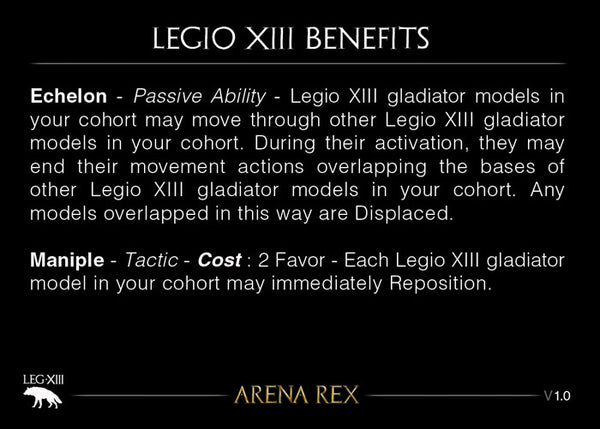Tactics Spotlight: Legio XIII September 9, 2015 22:29
Hi folks, and welcome to a new tactics spotlight.
Last week we covered Ludus Magnus, the great school of the Roman Republic. This week you’ll learn a bit more about their counterparts to the north: the Roman Imperial Ludus Britannicus, also known as Legio XIII.
Without the Republic’s political need to divorce gladiatorial spectacle from the military, the Empire embraces the connections between bloodsport and pitched battle. Gladiators from schools across the empire are still called into military service in times of conflict, and retired gladiators often find themselves under Imperial retainer as specialty close combat trainers for promising recruits. Live steel training exercises between Imperial Legionnaires are not uncommon, which makes the arena like a second home for many of them.
Due to the adoption of many auxiliaries and a willingness to embrace their tactics, Imperial Legions are far less regimented and polished than their Republican counterparts. Even so, the empire’s citizenry takes soldiering to heart, and recruits from any region are trained to stand by each other as individuals and hold the line just the same. Further, the military sponsoring of Legio XIII means that while Imperial Legions may be more individualistic than the Republican conscript legions, the gladiators of Legio XIII are far more comfortable operating in lockstep and formation while effectively responding to threats in the arena.
Generally high armor and vitality stats allow Legio XIII to weather quite a beating and still swing back at their foes. While slightly slower on average than most other schools, their passive ability Echelon allows them to retire injured or exhausted combatants from the front lines and protect them, while at the same time moving fresh gladiators in to finish off weakened foes. Echelon alone gives Legio XIII a lot of board control when they form up; your opponents will struggle to reach your vulnerable models while you can reach theirs. Clever use of Maniple can really isolate opposing gladiators as well, surrounding them with Legio models and leaving them without any support.
In addition, Aemilia, Ban-luca and Aquila all have Coordinated Strike, meaning that small pushes into one of these models can make for big damage from extra successes. Urien is a great front-line pusher with Momentum, and it’s easy to take advantage of Hot-Blooded when you can use Echelon to keep him safe while he’s exhausted. Gaius Pallidus is a great second-rank gladiator, healing a bit of vitality here and there to keep your troops fresher than they ought to be. He also makes a tough last man standing, and must be finished off quickly since every turn becomes a clear turn. Sulla adds even more depth to Legio XIII’s toolbox with his Dictate ability and Exploit tactic, and Veteran allows the old man to hold his own even in a bad situation as long as his Favor holds out.
If Ludus Magnus is the shining gem of the arena, Legio XIII is the stone used for polishing. It doesn’t have to be flashy, and nobody expects it to be. All it has to do to be useful is wear others down, and ensure that in the end it isn’t the one that breaks. Join us next week as we uncover some of the mysteries of Antonian Aegyptus and the rites of the Morituri.





